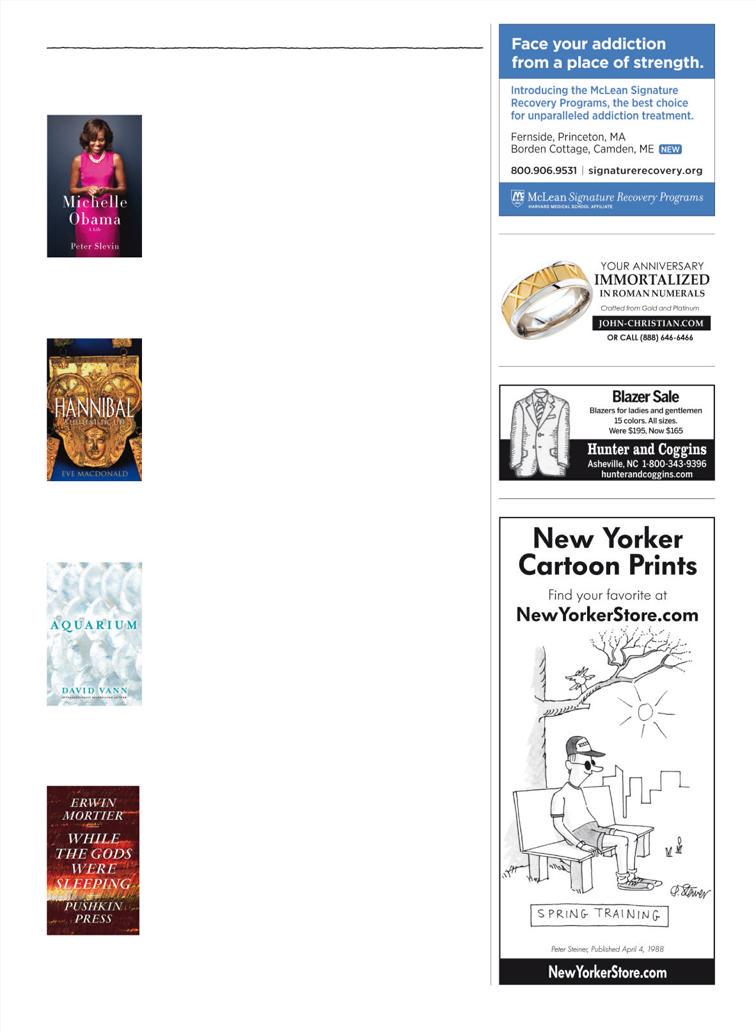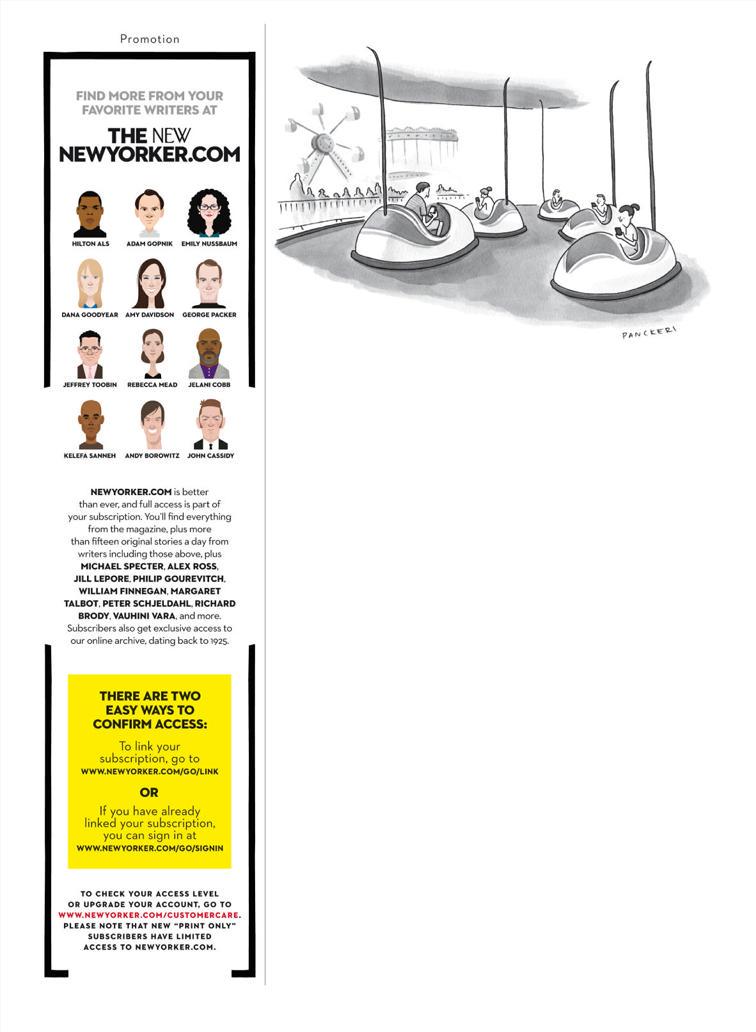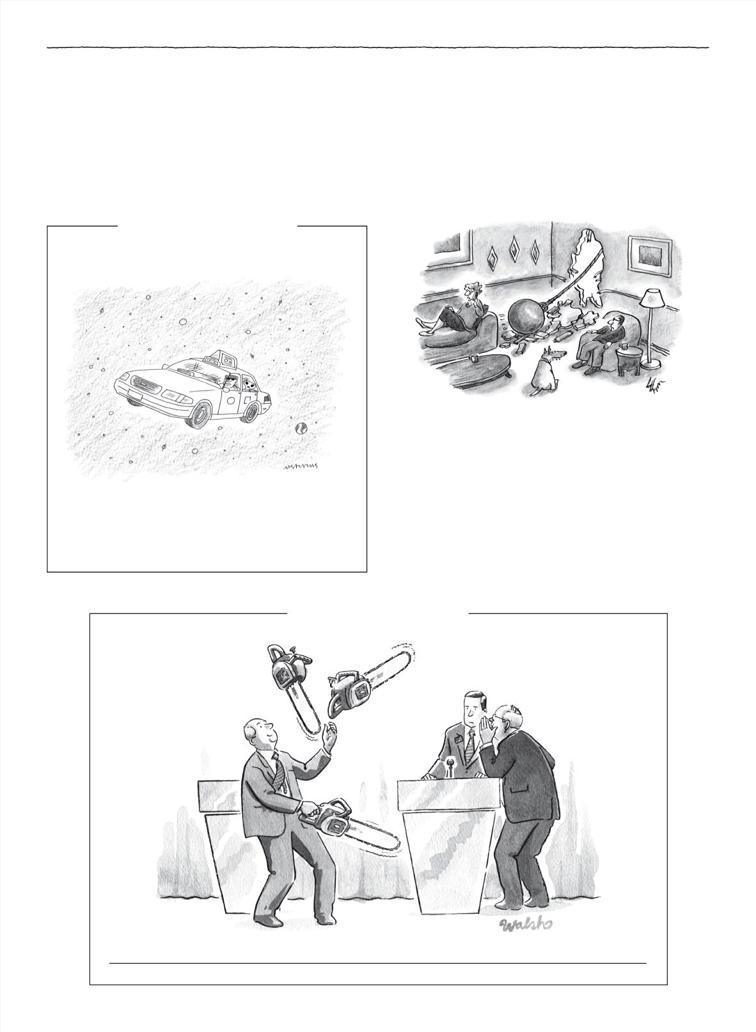
22 minute read
Briefly Noted charles McGrath 78 A new biography of Joseph Mitchell.
BRIEFLY NOTED
MICHELLE OBAMA, by Peter Slevin (Knopf). After Barack Obama was elected to the Illinois State Legislature, his wife warned him, “This business is not noble.” Slevin argues that the question of how to make a difference while also having a good life has been a constant one for Michelle Obama—from her childhood, on the South Side of Chicago, to Princeton, Harvard, and her legal career. His book is better at explaining how she became the person who arrived at the White House than how she operates now. The Michelle who emerges fully understands the transformative value of being an African- American First Lady; she also has a conservative streak. When Barack, dawdling over proposing, would ask if marriage really mattered, she’d say, “Marriage is everything.”
Advertisement
HANNIBAL, by Eve MacDonald (Yale). This taut study of the Carthaginian commander unfolds at the intersection of myth and history. Hannibal, described by Livy as “by far the best soldier” ever to set foot on a battlefield, acquired a reputation as Rome’s most fearsome enemy. His invasion of Italy— tens of thousands of troops crossing the Alps—stunned the Romans. MacDonald argues that Roman historians magnified Hannibal’s ferocity to add to the glory of Rome’s eventual triumph. She paints him as a Hellenistic leader who built an army around strong personal ties. She also follows his myth through the ages, from Napoleon’s determination to lead his own army over the Alps to Freud’s fascination with Hannibal’s strong-willed father.
AQUARIUM, by David Vann (Atlantic). This wrenching novel focusses on a lonely twelve-year-old girl’s relationship with her emotionally disturbed mother. Caitlin spends her days at the Seattle aquarium, admiring the tranquillity of undersea creatures, while her single mother, Sheri, works a gruelling shift at the docks. Their fragile familial harmony shatters when Sheri’s estranged father attempts to befriend Caitlin and indirectly revives a dark history of abuse. In bracing prose, Vann shows Caitlin’s home becoming a claustrophobic prison, as much a glass tank as the ones that contain the fish she admires. “She had always been my safety,” Caitlin reflects after one of Sheri’s explosive incidents. “To have this place become unsafe left nowhere else.”
WHILE THE GODS WERE SLEEPING, by Erwin Mortier, translated from the Dutch by Paul Vincent (Pushkin Press). Mortier, a Belgian novelist, has translated Virginia Woolf, and her vatic inventories of domestic life echo in his writing. His narrator, Helena, is an elderly witness to Europe’s turbulent twentieth century. She describes horrific things she saw in the First World War’s trenches but, a fierce aesthete, is unabashed by pleasures that she experienced close to the front. “The war was the best thing that ever happened to me,” she confesses. Her hedonism earns her the scorn of her mother and her daughter. The novel’s only false note is Helena’s frequent apologies for rhapsodizing—it’s clear that she needs to, and the book is the pearl that results from these shining accretions.
THE PEOPLE YOU MEET
How a newspaperman from the South became New York’s great chronicler.
BY CHARLES MCGRATH
Joseph Mitchell (right) was drawn to lives on the margins of a vanishing world.

Thomas Kunkel’s “Man in Profile: Joseph Mitchell of The New Yorker” (Random House) is a book about someone who may seem, except to longtime students of this magazine, an odd and unpromising subject for a full-length biography. Mitchell was a staff writer at The New Yorker from 1938 until his death, in 1996. He had a cultlike following, but for most of his life his books were hard to find, and he never became a household name the way that, say, James Thurber or E. B. White did. He was more esteemed by his peers—revered, it’s not too much to say—than by the public: he was a writer’s writer, or even a writer’s writer’s writer. You can still see unmistakable signs of his influence—blocks of foursquare declarative sentences, a patient layering of detail, passages of precisely rendered dialogue, a tone of quiet amusement—in current New Yorker writers like Alec Wilkinson, Mark Singer, and Ian Frazier.
Mitchell practiced what he called a “wild exactitude,” and his style is hard to describe except by extensive quotation. His writing is at once spare and leisurely, lyrical and precise, funny and a little mournful. He was always on the lookout for oddness, as in his famous description of the bearded lady known as Lady Olga:
Her thick, curly beard measures thirteen and a half inches, which is the longest it has ever been. When she was young and more entranced by life under canvas, she wore it differently every year; in those days there was a variety of style in beards—she remembers the Icicle, the Indian Fighter, the Whisk Broom, and the Billy Goat—and at the beginning of a season she would ask the circus barber to trim hers in the style most popular at the moment. Since it became gray, she has worn it in the untrimmed, House of David fashion.
And he was also capable of something close to poetry, especially when describing the Hudson River:
I like to look at it in midsummer, when it is warm and dirty and drowsy, and I like to look at it in January, when it is carrying ice. I like to look at it when it is stirred up, when a northeast wind is blowing and a strong tide is running—a new-moon tide or a full-moon tide—and I like to look at it when it is slack.
If he could help it, Mitchell never wrote about anyone who was famous or newsworthy. He was drawn to people on the margins: bearded ladies, Gypsies, street preachers, Bowery bums, Mohawk steelworkers, the fishmongers at the Fulton Market. In the nineteen-thirties and forties, The New Yorker couldn’t get enough stories like this—barroom scenes were practically a subgenre—and Mitchell’s work overlaps somewhat with that of A. J. Liebling, his best friend at the magazine, and of elbow-bending New Yorker writers like John McNulty. In general, Mitchell has aged far better than they have. McNulty’s drunks no longer seem charming, and Liebling’s Broadway hustlers and Tin Pan Alley hangerson sometimes strain credulity. Liebling saw his people as “characters,” and mined them for their colorfulness; Mitchell was genuinely interested in his subjects as human beings, remarkable because they so vividly demonstrate that one way or another we are all a little weird. But Mitchell’s world was vanishing even as he wrote about it, and it now seems almost unimaginably distant from our own. Mitchell meant his stories to be lasting, and they are, but not quite in the way he intended. They resemble a bit the drawer pulls and pickle forks and electrical insulators he liked to collect: evocative, beautifully made artifacts from a bygone age.
Mitchell’s personal life was unexceptional. He was happily married to the same woman for forty-nine years. He liked to take a drink—more so than Kunkel acknowledges—but drinking did not make him boastful or quarrelsome or self-pitying, the way it did so many writers of his generation. It just made him sadder and more nostalgic. Mitchell was shy, courtly, and private, even slightly paranoid. (Once, when I was a young New Yorker editor, he took me aside and said in a near-whisper, “I read something in the Times today. Don’t tell anyone.”) He dressed like a businessman—wing tips, white shirt, Brooks Brothers suit, fedora or, in summer, straw hat—and he kept businessman’s hours, coming in at nine every day and leaving at six. He went into his office and shut the door and sat at his desk, and for thirty-two years, starting in 1964, he did this without publishing a word. In time, Mitchell became a cautionary figure, more
famous for not writing than for anything he actually wrote. At The New Yorker, people used to lurk outside his door listening for the sound of typing, and would scurry in when he left, looking for manuscript pages in the wastebasket. He would have hated to think so, but the mystery of his long silence adds an extra shine to what he did write, and it gives his biography shape and poignance.
Kunkel never quite solves the mystery. A former newspaper reporter and now a college president, he is the author of a solid biography of Harold Ross, the founder of The New Yorker, and he got to know and like Mitchell while researching it. The new book is careful, admiring, even adulatory—so uncritical that it sometimes diminishes its subject, draining the life from him. Kunkel doesn’t go in for theorizing or speculation, and there’s not a lot in his account—with one possible exception—that Mitchell fans didn’t already know or guess. In many ways, as the title implies, Kunkel’s Mitchell is a man captured in profile: an elusive figure still visible most clearly in his own writing.
Mitchell was born in Fairmont, North Carolina—farming country, on the coastal plain—in 1908. His father, Averette Nance, was a dour, humorless, self-made man who became a prosperous cotton and tobacco broker and one of the largest landowners in the area. “I very rarely feel altogether at ease with my father and haven’t since I was a child,” Mitchell wrote when he was in his sixties. “He is still able to make an offhand remark and cut me to pieces.” If you wanted to psychologize—something that Kunkel generally avoids—Mitchell’s relationship with his father would surely be the place to start.
Unlike his father, Mitchell’s mother, Elizabeth, had been to college; she was also sweeter and kinder, and from her he developed an early love of reading. To his father’s lasting disappointment, Mitchell had little desire to become a farmer, and, as a sort of fallback, he was sent to the University of North Carolina to study medicine. He was hopeless with numbers, which not only ruled out premed but made it impossible for him to get a regular degree. So for four years Mitchell stayed in Chapel Hill as a socalled “special student,” taking whatever courses he felt like, mostly literature and journalism, and writing for not just the campus publications but some of the better North Carolina newspapers. In 1929, on the eve of the stock- market crash, he decided to move to New York and try his luck with the papers there. On hearing the news, his father looked at him sadly and said, “Son, is that the best you can do, sticking your nose into other people’s business?”
New York in the nineteen-thirties was heaven for Mitchell. He quickly landed a job at the Herald Tribune, and began exploring the city on foot—all his life, he was a tireless walker—and by hanging out in the neighborhood police stations. A great noticer of things from boyhood, he became a careful listener as well, developing a matchless ear for New York speech. In 1931, Mitchell was fired from the Trib after flinging an inkwell at the publisher’s wall in a drunken fit of temper, but after a stint as a deckhand on a freighter sailing to the Soviet Union he landed a job at the World-Telegram, then thought to be “the writer’s paper. ” He soon became such a star that his name was featured on the side of the delivery trucks. He covered the Lindbergh trial; did celebrity profiles of people like Bing Crosby, Noël Coward, and George Bernard Shaw; and brought particular care to stories about New York’s oddballs—strippers, street preachers, voodoo worshippers. Many of these pieces were assembled in a 1938 collection called “My Ears Are Bent,” and they still sparkle. There were a lot of them, moreover. The writer who in later years had trouble finishing anything was sometimes turning out two or three features a day. Mitchell was still prolific when he moved on to The New Yorker, in September, 1938. The slowdown was gradual, and can be explained mostly by the greater length of the stories he was able to do and by the care he was putting into them, cutting and pasting, writing and rewriting. He became a much more deliberate and consciously literary writer than most of his contemporaries at the magazine. The critic Stanley Edgar Hyman first pointed out that the people Mitchell wrote about more and more resembled himself: loners, depressives, nostalgists, haunters of the waterfront, cherishers of arcane information. The characters in his pieces began to share a similar voice; they all sounded a little like Mitchell. The self-identification became complete in Mitchell’s most famous piece and, as it happens, the last one he published, “Joe Gould’s Secret.” Joe Gould was a Village character who lived on handouts and was famous for doing seagull imitations at parties and for a multivolume compendium of conversations that he had supposedly overheard called the “Oral History of Our Time.” Mitchell published a mostly admiring and unskeptical profile of Gould in 1942, and returned to the subject in 1964 with a revisionist view. Gould was a fraud, he reveals, and the “Oral History” didn’t exist except in a handful of pages that said the same thing over and over again. Then, in a startling about-face, Mitchell not only forgives Gould—on the ground that he probably thought he had the “History” all in his head and just needed to put it down on paper—but confesses that he is guilty of the same thing, having walked around for years with a great Joycean novel of New York in his own head, a book not quite written yet so vivid in his mind that he can practically see the title page. Years later, after Mitchell stopped publishing, the critic Norman Sims asked him why he found Gould so interesting. “Because he is me,” Mitchell replied.

After Mitchell’s death, his fans, just like Salinger’s, hoped that among his papers might be piles of publishable manuscripts. It now appears that there was no such trove. There were letters, notes, diaries, and false starts, but only two and half chapters of an uncompleted memoir (all of which have recently been published in The New Yorker). Yet Mitchell’s drafts and notes allowed Kunkel to make some discoveries that may disturb and disappoint Mitchell admirers. More than we knew, or wanted to know, he made things up. It’s no secret that the character of Mr. Hugh G. Flood—an elderly, eccentric waterfront dweller who figures in three famous Mitchell stories—was a composite. Mitchell admitted this when the Flood stories were republished in book form, in 1948, though careful readers could have surmised as much on their own. There’s the poetic name (which may be an allusion to Edwin Arlington Robinson’s “Mr. Flood’s Party”), the fact that

Flood and Mitchell shared a birthday, and the fablelike quality of some of the scenes. According to Kunkel, though, there were other fabrications: the character of Cockeye Johnny Nikanov, the self-styled King of the Gypsies and the subject of a 1942 Profile so popular that Sidney Sheldon, of all people, wanted to base a musical on it, combined traits from several Gypsies Mitchell had known. (Because Mitchell wanted the rights to a Gypsy musical of his own, he told the magazine’s lawyer, “Cockeye Johnny Nikanov does not exist in real life, and never did.”) And in all likelihood Orvis Diabo, the central figure in a vivid and still revealing Mitchell piece about the Mohawks who worked in high steel, was also a construct.
Mitchell, it should be said, was not the only New Yorker writer in the thirties and forties to take liberties. Composites and invented figures were an old, if not honorable, journalistic tradition and a standby of newspaper feature writing. St. Clair McKelway, a New Yorker editor and writer who recruited Mitchell to the magazine, resorted to it, and, in some of his urban sketches, so did Liebling, barely bothering to disguise what he was up to. (His war reporting seems beyond reproach.) But this biography’s most confounding revelation is that Harold Ross, a famously nitpicking literalist and stickler for accuracy— an early advocate of magazine fact- checking—was apparently not only aware of Mitchell’s composites but encouraged him. It’s as if Kunkel had caught Jonathan Edwards secretly winking at adultery.
Ross must also have known that Mitchell regularly doctored his quotes, stitching together bits of conversation into protracted monologues and sometimes switching chronology. This, too, careful readers could have guessed—no one really talks in paragraphs as long and eloquent as some of Mitchell’s characters do—and Kunkel has found notes and revisions that prove it. As journalistic offenses go, fudging a quote is a far lesser offense than making up a character, and here again Mitchell was not alone at The New Yorker or elsewhere. Well into the era of Ross’s successor, William Shawn, one of the magazine’s hallmarks was long, unbroken quotations that now seem suspiciously articulate. Writers regularly transposed conversations, turning something said at lunch, say, into a remark made at dinner. The practice wasn’t officially condoned, but some of the magazine’s very best writers did it. There were even New Yorker writers who didn’t take notes or use tape recorders but reconstructed (or reimagined) long quotations from memory. The subjects seldom, if ever, objected, because, even if they didn’t recognize what they were quoted as saying, it usually sounded like something they might wish they had said.
Kunkel defends Mitchell’s practice on the somewhat wobbly ground that it allows for a higher truthfulness, a
faithfulness that goes beyond mere factual accuracy. He also says that the results are more literary and artful than an untouched transcription might be, and in this he is certainly right. Mitchell’s best work is lovely and stirring in a way that a documentary or a recorded interview could never be. George Hunter, an elderly black man and Staten Island resident, and the subject of a story that is probably Mitchell’s masterpiece, would be less interesting if we had to read what he actually said. And yet the piece gains immeasurably from being presented as factual, an account of scenes and conversations that really took place. If we read it as fiction, which it is, in part, some of the air goes out.
As inglorious examples like Jayson Blair demonstrate, invention is often easier than reporting—you can do it without even leaving home—and requires no special talent other than nerve. But fabricators are now the exception; the rules of journalism have changed, and it’s widely accepted—or ought to be—that what appears between quotation marks is a reasonably accurate representation of what someone has said at the time he or she is supposed to have said it. It’s tempting to think that this represents a new scrupulousness and high-mindedness on the part of journalists. But it may be that more people don’t try fabricating only because now, when we’re more used to reading real speech (and when what people say is so easily picked up on smartphones and video cameras), it’s harder to get away with. Mitchell’s best defense is that he wrote what he did out of affection and empathy for his subjects, not a wish to deceive.
Mitchell appears to have felt uneasy about the composites, but to judge from Kunkel’s account he saw nothing wrong with massaging his quotes. The most likely explanation for his block wasn’t any sense of guilt but that he was a depressive by nature and became imprisoned by his own reputation—by the mythology that had grown up around him. The longer he went without producing anything, the more pressure he felt to come up with a masterpiece, and his standards by then had transcended those of mere magazine journalism.
In the late nineteen-eighties, I became Mitchell’s editor at The New Yorker, a strictly nominal post by then. (I was interviewed by Kunkel, and am quoted a few times.) Once a year, Mitchell would report to my office and bring me up to date on what he was doing. In the beginning, as I recall, he talked about working on a memoir about his family and growing up in North Carolina. Then, in what seemed to me a shift in enthusiasm, he talked about his early newspapering days in New York, and in particular about his friendship with a woman named Ann Honeycutt. Honey, as she was called, really would make a great magazine piece. She was a funny, pretty, hard-drinking Louisiana-born blonde who became something like the collective girlfriend of a whole generation of New Yorker writers and editors. Wolcott Gibbs, Thurber, and Geoffrey Hellman were all in love with her at various times; McKelway married her, though only briefly; and Liebling and Mitchell couldn’t get enough of her company. Whenever he spoke of her to me, Mitchell’s spirits seemed to lift.
According to Kunkel, Mitchell’s papers suggest that as early as the nineteen-seventies he was planning a largescale autobiographical work that would toggle back and forth between North Carolina and New York, which is what the unfinished memoir does, though Honeycutt never makes an appearance. The existing chapters seem rather obsessive, circling around and around the same themes, and the last, incomplete section begins with an admission that Mitchell is now helplessly “living in the past.” Something has also happened to the writing. It’s mannered, self-conscious in a way that classic Mitchell never was, with the sentences growing longer and longer and more intricate. They feel like Penelope’s web, woven to stave off an ending.
In Kunkel’s telling, Mitchell’s silence is sad, not tragic. Mitchell was clearly pained and embarrassed by his failure to finish anything, but he also made peace with it. Years after he stopped publishing, he even asked for a raise— believing, probably rightly, that he had been underpaid during the years when he was producing—and Shawn gave him one. Ultimately, what happened to Mitchell is an extreme version of what happens to most writers: your powers decline, the vision of what you want to attain becomes more and more distant, the words dry up or don’t come out the way you want. In Mitchell’s case, the diminuendo was especially long, and his continued expectations for himself much higher. But he never pitied himself, or expected anyone else to. Almost to the end, he kept hoping that inspiration might yet strike.

THE NEW YORKER IS A REGISTERED TRADEMARK OF ADVANCE MAGAZINE PUBLISHERS INC. COPYRIGHT ©2015 CONDÉ NAST. ALL RIGHTS RESERVED. PRINTED IN THE U.S.A.
VOLUME XCI, NO. 10, April 27, 2015. THE NEW YORKER (ISSN 0028 792X) is published weekly (except for five combined issues: February 23 & March 2, June 8 & 15, July 6 & 13, August 10 & 17, and December 21 & 28) by Condé Nast, which is a division of Advance Magazine Publishers Inc. PRINCIPAL OFFICE: Condé Nast, 1 World Trade Center, New York, NY 10007. Elizabeth Hughes, publisher, chief revenue officer; Beth Lusko, associate publisher advertising; James Guilfoyle, director of finance and business operations; Fabio Bertoni, general counsel. Condé Nast: S. I. Newhouse, Jr., chairman; Charles H. Townsend, chief executive officer; Robert A. Sauerberg, Jr., president; David E. Geithner, chief financial officer; Jill Bright, chief administrative officer. Periodicals postage paid at New York, NY, and at additional mailing offices. Canadian Goods and Services Tax Registration No. 123242885-RT0001.
POSTMASTER: SEND ADDRESS CHANGES TO THE NEW YORKER, P.O. Box 37684, Boone, IA 50037 0684. FOR SUBSCRIPTIONS, ADDRESS CHANGES, ADJUSTMENTS, OR BACK ISSUE INQUIRIES: Please write to The New Yorker, P.O. Box 37684, Boone, IA 50037 0684, call (800) 825- 2510, or e-mail subscriptions@newyorker.com. Please give both new and old addresses as printed on most recent label. Subscribers: If the Post Office alerts us that your magazine is undeliverable, we have no further obligation unless we receive a corrected address within one year. If during your subscription term or up to one year after the magazine becomes undeliverable, you are ever dissatisfied with your subscription, let us know. You will receive a full refund on all unmailed issues. First copy of new subscription will be mailed within four weeks after receipt of order. For advertising inquiries, please call Beth Lusko at (212) 286-4454. For submission guidelines, please refer to our Web site, www. newyorker.com. Address all editorial, business, and production correspondence to The New Yorker, 1 World Trade Center, New York, NY 10007. For cover reprints, please call (800) 897-8666, or e-mail covers@cartoonbank.com. For permissions and reprint requests, please call (212) 630-5656 or fax requests to (212) 630-5883. No part of this periodical may be reproduced without the consent of The New Yorker. The New Yorker’s name and logo, and the various titles and headings herein, are trademarks of Advance Magazine Publishers Inc. Visit us online at www.newyorker.com. To subscribe to other Condé Nast magazines, visit www.condenet.com. Occasionally, we make our subscriber list available to carefully screened companies that offer products and services that we believe would interest our readers. If you do not want to receive these offers and/or information, please advise us at P.O. Box 37684, Boone, IA 50037 0684 or call (800) 825-2510.
THE NEW YORKER IS NOT RESPONSIBLE FOR THE RETURN OR LOSS OF, OR FOR DAMAGE OR ANY OTHER INJURY TO, UNSOLICITED MANUSCRIPTS, UNSOLICITED ART WORK (INCLUDING, BUT NOT LIMITED TO, DRAWINGS, PHOTOGRAPHS, AND TRANSPARENCIES), OR ANY OTHER UNSOLICITED MATERIALS. THOSE SUBMITTING MANUSCRIPTS, PHOTOGRAPHS, ART WORK, OR OTHER MATERIALS FOR CONSIDERATION SHOULD NOT SEND ORIGINALS, UNLESS SPECIFICALLY REQUESTED TO DO SO BY THE NEW YORKER IN WRITING.
Each week, we provide a cartoon in need of a caption. You, the reader, submit a caption, we choose three finalists, and you vote for your favorite. Caption submissions for this week’s cartoon, by Liam Francis Walsh, must be received by Sunday, April 26th. The finalists in the April 13th contest appear below. We will announce the winner, and the finalists in this week’s contest, in the May 11th issue. The winner receives a signed print of the cartoon. Any resident of the United States, Canada (except Quebec), Australia, the United Kingdom, or the Republic of Ireland age eighteen or over can enter or vote. To do so, and to read the complete rules, visit contest.newyorker.com.
THE WINNING CAPTION
“This way we avoid the turnpike.” Louise Schiller, Oakland, Calif.

THE FINALISTS “Miley’s here.” Tyler Smith, New Haven, Conn.
“Why, yes, I am interested in homeowner’s insurance.” Benjamin F. Remo, Easton, Md.
“Hold on, I heard a knock.” Bren Finan, Dublin, Ireland
THIS WEEK’S CONTEST






